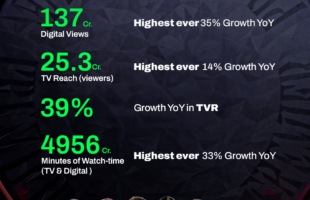Events like the annual Asian Television Forum – now in its 12th year – are an attempt to peer into the future via crystal ball. At this year’s event, more than 3,500 participants from across the television spectrum are expected to converge at Marina Bay Sands’ convention centre, essentially to ask, and possibly answer, the question: “Where do we go from here?”
“The theme of this year’s ATF is ‘Evolve, Explore, Experience,” says Yeow Hui Leng, Project Director at Reed Exhibitions, which organizes the Forum. “Over the past decade, the media landscape has changed dramatically – a paradigm shift that we aim to depict in this edition. This is a platform for participants to explore opportunities in the fast-evolving Asian content industry and to experience the vast array of content and new media platforms available.”
When the ATF made its debut, the television industry in Asia was a simpler place – a space dominated by terrestrial programming but with the promise of new technological revolutions on the horizon. Today, television is big business, with satellite, cable and internet services reshaping the industry and digitization bringing more benefits to consumers. Over the course of just ten years, the tectonic upheaval has upended entrenched monopolies of government broadcasting services, launched new players – Singapore’s mio, Thailand’s Ving and India’s Tata Sky to name a few – and nudged entrenched players from MediaCorp to NHK, MediaPrima to CCTV, to adapt and keep pace within the new ecosystem.
“Digital will be a key theme (at this ATF 2011) as this is a fast-changing part of our business,” says a spokesperson from BBC. “We are looking forward to meeting our new digital partners to explore all possibilities and make BBC Worldwide content easily accessible to audiences everywhere.”
This is a key point, because the digital revolution has shifted the nexus of television programming from merely broadcaster to content engager. Where television in Asia was once the bastion of state programmers or foreign imports, technology and entrepreneurship in Asia has generated a creative content sector, accessing the region’s diverse and discerning audiences in different ways – via TV, PC, smartphone and even game consoles.
Over its three days (7 – 9 December), the ATF 2011 will aim to sum up the state of the industry as it stands and offer insights into current trends and issues impacting the landscape, not just in Asia but the world. Buyers attending the forum are typically Asian (96%), but sellers range widely (58% from Asia, 27% from Europe, 9% from the Americas and 6% from the Middle East and Oceania). Spotlight sessions on China, Malaysia and Asian animation form the crux of the itinerary this year, as well as a Media Leader’s forum and a keynote session organized in collaboration with MIPFormats.
Reed Exhibitions said last year’s Forum brought together 850 companies from more than 53 countries. In its wake, it generated almost US$150 million worth of broadcasting and licensing deals, a 68 per cent increase over 2009. This year, those numbers look likely to increase even further. And with Asia’s appetite for televised content continuing to rise, events like the ATF become increasingly important as a focal point for a diversified, asymmetrical Asia.
“Compared to the US and Europe, Asia still pays conservatively for content and is generally more protective towards the import of foreign content,” says Yeow. “But as Asian audiences mature, the industry can only continue to strengthen and liberalize. The TV production industry here is also making significant progress in generating quality content, and as the region becomes more confident and comfortable in its own productions, demand will grow locally and internationally, tying into the ambitions of exporting Asian culture and content to a global audience. This, in turn, will cultivate a whole new generation of Asian talent and decision-makers that are familiar with the international content scene and can meet those standards.”
Just as the nature of content delivery in Asia has changed markedly over the past decade, the range and variety of content on offer is expected to change over the next. The BBC predicts that television will become even more locally relevant and that multiple screens will become the norm of viewing experiences, but above all, content will still be king.
This is the same for emerging content markets, also steadily developing a thirst for colourful and diverse programming. One, the Cambodian Broadcasting Service, expects content providers in individual countries to ramp up their licensing, cloning and adaptation of programmes that are globally popular into successful local versions. It also expects that imported finished programmes will diminish in demand, while scripted and local original content will rise.
The digital television shift – bringing along with it technologies such as VOD, IPTV and Over-The-Top (OTT) services – will also increasingly blur the line between TV and internet, converging the two into a hybrid model that brings new opportunities and challenges. Further into the future, Adam Ham, Executive Director of GCMA in Malaysia, foresees technology taking TV to even greater heights. “Producers are having to quickly re-engineer their creative process to address demand as it evolved, moving into developing High Definition and stereoscopic 3D digital content. And in 10 or 20 years, I believe that all of us will be spoilt for choice in front of 4D interactive mega television screens.”
How exactly and at what pace television broadcasters, distributors and content makers reach tomorrow’s Asian audiences is the million dollar question at this year’s ATF.








